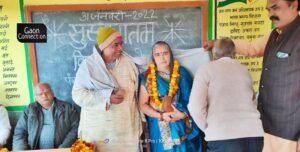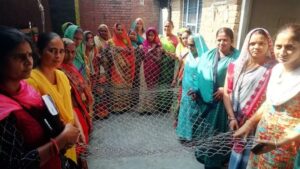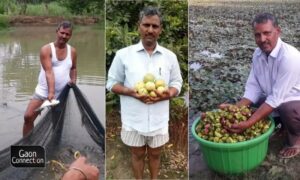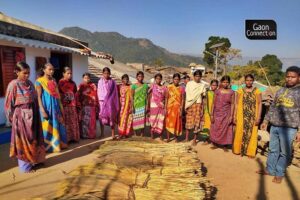Just a couple of weeks ago, all 229 villages in Chhattisgarh’s Dantewada district were in the grip of the COVID19 pandemic’s second wave. Now, 69 per cent of these villages, many of them predominantly tribal, have been declared coronavirus-free.
“We will be able to make the remaining villages COVID-free in our district by June 15,” Deepak Soni, Dantewada district magistrate, told Gaon Connection.
To render villages COVID-free and monitor their progress, the administration “is conducting review meetings with the panchayat, sarpanch (village head) and corona awareness teams every fortnight”, said Soni.
“We have chosen local tribal leaders at the village level who can communicate in Gondi. Audio and video messages in Gondi and Halbi languages help tribal communities understand corona-related programmes better,” Soni added.
Besides Dantewada, other districts in the central Indian state are also on the way to being declared COVID-free. Of the state’s 28 districts, at least 12 have announced their villages are corona-free. Last month, on May 27, the state government had said nearly 10,000 of the state’s 20,000 villages were free of the virus, meaning half the villages no longer had a single active COVID-19 patient.
Also Read: Half of Chhattisgarh’s villages have become COVID-free, says the state govt
Corona Jagrukta Dal
To rid villages of the virus, the Dantewada district administration said it adopted a multi-pronged approach. Door-to-door surveillance by anganwadi workers, monitoring of those in home isolation, awareness programmes in the tribal Gondi and Halbi languages and setting up of quarantine centres were some of the measures taken.
At the heart of this campaign to get rid of the virus are the Corona Jagrukta Dals (Corona awareness teams). Its members include local teachers, anganwadi workers, mitanins (women healthcare workers) and health department staff who have been put on round-the-clock duty.
Anita Sahu, a 36-year-old anganwadi worker from Dantewada district, is part of one such Corona Jagrukta Dal. “The maximum problem was in April. Thereafter, door-to-door surveillance was launched. We used to set out in the morning and only return by evening, every day. It was a lot of work,” Sahu told Gaon Connection.
Any person showing COVID-like symptoms — cough, cold or fever — was immediately referred to a hospital for testing, and medicine kits, comprising vitamins and paracetamols, were provided.
“The time lag of one or two days for the COVID test report could be crucial for a patient, so we provided medicine kits to those with symptoms without any delay,” the district magistrate said.
Also Read: Every second COVID case and death reported in May 2021 was from rural India
Thirty-seven-year-old Pankaj Bhadouria remembers the horror of the second wave in his village Nakulnagar in Dantewada. “Last month, corona spread like wildfire in villages. But, the situation is under control now. Zero wale kayi gaon hain yahan [There are many villages with zero COVID cases in our district],” he told Gaon Connection.
Bhadouria’s mother was diagnosed with COVID too. “She tested positive nearly twenty days ago. The district team used to call us regularly to monitor her pulse, oxygen level and medicines for the day. Besides medicine kits, we were also given an oximeter,” he said, adding that there were only two or three active cases in his village now.
Awareness programmes in tribal languages
Dantewada district is inhabited by several tribal groups, and taking the message of COVID precautions and vaccination to these communities means communicating in their local languages. This is why the district administration decided to rope in tribal leaders who helped raise awareness in Gondi and Halbi languages.
“We chose local leaders who could communicate in Gondi and Halbi languages at the village level to take the message far and wide,” informed Soni.
“We also requested leaders from different tribal communities to motivate their members to get vaccinated. We got the leaders vaccinated first so that they could be a role model for others,” added the district magistrate.
Vaccination perks
According to the Dantewada district administration, over 95,000 vaccine doses have been administered in the district so far and about 80 per cent of villages in the district have achieved their 45-plus category target in 25 days.
“Vaccination is happening at a good pace in our village. All of us have worked really hard for this,” said Sahu, the anganwadi worker.
Meanwhile, to ensure vaccination of tribal communities living in remote villages, at least 20 buses have been made available.
“These buses transport villagers to vaccination centres, where cooked food is also provided,” said Bhadouria, who recently got the COVID vaccine in one of the 22 government-run vaccination centres in the district.
Also Read: Addressing vaccine hesitancy in rural India, one jab at a time
Further, the administration had made arrangements to ensure villagers who come to vaccine centres also finished their other government-related work. These include works related to the Ayushman card, labour registration, pension scheme and Kisan Credit Card, said Soni.
Additionally, hospital beds and ICUs have also been upgraded, claims the district administration. On April 23, the highest peak of new COVID cases — 17,397 — were reported in the state. On June 6, just 999 new cases were reported — a drop of 94 per cent in six weeks.
No scientific basis for COVID-free declarations
While the district administration is hoping to declare all villages COVID-free by June 15, some public health experts are raising doubts over such announcements. Raipur-based Sulakshan Nandi, national co-convener of Jan Swasthya Abhiyan, a non-profit working for public health and health rights in Chhattisgarh, said that “announcements such as declaring areas “covid-free’ are nothing but gimmicks”.
“These declarations do not have any scientific basis. Last year, in April, Goa declared itself as the first “corona-free” state. It is not like you have eradicated COVID-19 from the area, like we can say for diseases like smallpox,” Nandi told Gaon Connection.
“In the second wave, Chhattisgarh has faced huge challenges with regard to monitoring home isolation and referrals. People also faced huge problems in travelling to higher health centres in case they had a serious ailment, as the lockdown was on and government referral was inadequate,” Nandi added.
The public health expert also pointed out that people in rural areas or in urban slums do not have oximeters or thermometers, and the government did not arrange for them in all villages or urban slums.



















